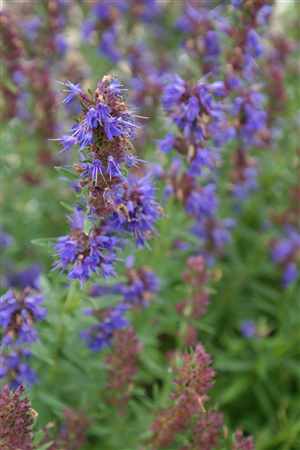Hyssop (Hyssopus officinalis)
Main Facts about Hyssop

Hyssop is a perennial subshrub up to 2 feet (60 cm) tall. It is multi-stemmed from the base, and has small lance-shaped opposite leaves and dense spikes of blue double-lipped flowers that are highly attractive to bees and butterflies. The plant has a medicinal odor that becomes more mint-like when the leaves are crushed. Hyssop grows freely in the Mediterranean region, especially in the Balkans and in Turkey.
Parts used – flowers and leaves.
In times past, when people rarely bathed and farm animals often shared human living quarters, Hyssop’s crushed leaves, flowers, and branches were scattered around homes, placed on the floors of sickrooms and kitchens to mask odors.
The ancient Greek physician Hippocrates named the plant Hyssopus, from the Hebrew “ezob”, meaning “holy herb” – although it is not the same Hyssop mentioned in the Bible. The biblical Hyssop is believed to be another member of the mint family, Origanum syriacum.
Colonists introduced Hyssop into North America and used the herb to treat chest congestion.
Using Hyssop
Hyssop is a member of the aromatic mint family, and its volatile oil contains several soothing camphor-like constituents plus marrubiin, which is a strong expectorant. The plant also contains compounds that have antiviral, antibacterial, antispasmodic, and anti-inflammatory properties.
Hyssop is recommended to relieve the symptoms of colds, flus, and other respiratory infections, as well as asthma in both children and adults. It is also useful for treating indigestion, gas, bloating, and colic.
Externally, a poultice or a compress of crushed Hyssop leaves can soothe skin inflammations, cuts, burns, wounds, and bruises.
Hyssop inhibits the growth of herpes simplex virus, which causes genital herpes and cold sores.
The plant contains diosmin, a compound that helps strengthen veins. Hemorrhoids, a type of varicose vein, may benefit from treatment with Hyssop.
To make a compress for treating herpes, use 1 oz. of dried herb per pint of boiling water. Steep for 15 min and let cool. Soak a clean cloth in the infusion and apply it to cold sores and genital herpes sores as needed.
For an infusion to treat cough, varicose veins, or hemorrhoids, use 2 tsp. of herb per cup of boiling water, steep for 10 min, and strain. Drink up to 3 cups a day.
Hyssop is a remedy for: Cold and flu, Hemorrhoids
Cooking with Hyssop
Hyssop tastes like a combination of Sage and Peppermint. Traditionally, people used it to flavor soups and meat dishes.
Try adding small amounts of this strong-flavored herb to bean dishes, salads, and fruit dishes.
Hyssop is an ingredient in Chartreuse liqueur and a renowned flavoring for honey in France.
The dried flowers and leaves are used to make a tea for sore throats and bronchitis.
How to grow Hyssop
Hyssop requires a sunny, well-drained position, and is not fussy about the soil. Propagate Hyssop by seed, root division, or cuttings.
The plants require a minimum spacing of 2 feet (60 cm), although the distance can be halved if you are using Hyssop for hedging.
To prevent plants from becoming “leggy”, lightly prune after flowering and again in spring.
Harvest the leaves or flowers at any time and use them fresh or dried.
| Horse Chestnut tree |
Jackfruit
|